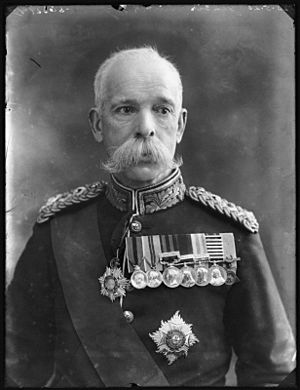Arthur Wynne (British Army officer) facts for kids
Quick facts for kids
Sir Arthur Wynne
|
|
|---|---|

General Sir Arthur Wynne
|
|
| Born | 5 March 1846 |
| Died | 6 February 1936 (aged 89) |
| Allegiance | United Kingdom |
| Service/ |
British Army |
| Years of service | 1863–1911 |
| Rank | General |
| Commands held | 6th Division Eastern District 10th Division Cape Colony District 11th Infantry Brigade |
| Battles/wars | Second Anglo-Afghan War Mahdist War Second Boer War |
| Awards | Knight Grand Cross of the Order of the Bath Mentioned in Despatches Order of the Medjidie, 3rd Class (Ottoman Empire) |
General Sir Arthur Singleton Wynne (born March 5, 1846 – died February 6, 1936) was an important officer in the British Army. He came from an Irish family and held a very important job as the Military Secretary.
Contents
Sir Arthur Wynne's Military Journey
Starting His Career
Arthur Wynne started his army career in 1863. He joined the 51st Regiment of Foot as an officer. By 1868, he became the adjutant of his regiment. This meant he helped the commanding officer with daily tasks.
In 1877, Wynne became the Superintendent of Army Signalling. This was during a campaign in Iowaki. He made sure messages were sent quickly and clearly.
Serving in Wars
Wynne served in the Second Anglo-Afghan War starting in 1878. He was in charge of field telegraphs. These were important for communication during battles.
In 1885, he received an award called the Order of the Medjidie, 3rd Class. He got this award for his service in Sudan. By 1889, he was working at the Army Headquarters. He helped with important administrative duties.
Later, in 1891, Wynne became an Assistant Adjutant-General at the Curragh. He also worked with the General Staff in Malta and Aldershot.
The Second Boer War
Wynne played a big role in the Second Boer War. He was a Deputy Adjutant-General for the Natal Field Force in South Africa. After a tough battle called Battle of Spion Kop, he took command of the 11th Infantry Brigade. The previous commander had been killed.
During the Battle of the Tugela Heights in February 1900, Wynne was slightly hurt. Another officer, Colonel Walter Kitchener, took over his command. After he got better, Wynne was put in charge of the Cape Colony District. He stayed there until he returned to the United Kingdom in 1902. His bravery was noted in official reports.
Later Important Roles
After returning home, Wynne continued to rise in the army. In 1902, he became the Deputy Adjutant-General to the Forces. This was a very senior position.
He then commanded the 10th (Irish) Division in 1904. He also led the Eastern District. In 1905, he commanded the 6th Division. Finally, in 1906, he became the Military Secretary. This was a top job, advising the King on military matters.
Retirement and Other Duties
When he retired, Arthur Wynne was promoted to the rank of General. From 1911 to 1917, he was the Keeper of the Jewel House. This meant he looked after the Crown Jewels.
He also served as the colonel of the King's Own Yorkshire Light Infantry from 1913 to 1927. He lived in a place called Haybergill in Cumberland. He also held the title of Deputy Lieutenant of Westmoreland.
Sir Arthur Wynne's Family
Arthur Wynne's father was John Wynne. His mother was Anne Warren. She was the daughter of Admiral Sir Samuel Warren. Arthur Wynne was also a great-grandson of Owen Wynne.
On September 8, 1886, Arthur Wynne married Emily Mary Turner. They had three sons: Owen, Graeme, and Arthur. All three of their sons also served in the British army, following in their father's footsteps.

